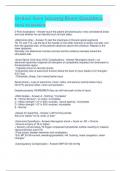2-Point localization - Answer-touch the patient simultaneously in two contralateral areas
and note whether he can identify touch on both sides.
.Abdominal reflex - Answer-To test the intactness of thoracic spinal segments
T8, T9, and T10, use the tip of the handle on the reflex hammer to stroke one side, and
then the opposite side, of the patient's abdomen above the umbilicus. Repeat on the
lower abdomen.
Normally, the abdominal muscles contract and the umbilicus deviates toward the
stimulated side.
.Acute Spinal Cord Injury (SCI) Complications - Answer-Neurogenic shock = an
abnormal vasomotor response d/t disruption of sympathetic impulses from brainstem to
thoracolumbar region
- Typically occurs in cervical injuries
"a temporary loss of autonomic function below the level of injury leads to CV changes"
S/S Triad
-Orthostatic, Brady, Can't sweat below injury
Spinal shock = Loss of autonomic, motor, reflex, and sensory activity below injury
No DTR, perianal reflex, motor and sensation
Despite paralysis, REMEMBER they can still have pain at site of injury!
.ASIA Grades - Answer-A - Nothing, *Complete*
B - *Some Sensory*, no motor, Incomplete
C - Motor strength *<3* in 50% muscles, *sacral sparing*, Incomplete
D - Motor strength *>3* in 50% muscles, Incomplete
E - Normal
.Assess for dysarthria - Answer-(=diff forming words)
Ask pt to repeat "no ifs, ands, or buts"
.Autonomic Dysreflexia - Answer-Neurogenic shock = Acute vs. AD = Chronic
• Occurs at injury of T6 or higher
= Sensory nerves below T6 trigger unopposed sympathetic outflow resulting in massive
vasoconstriction and HTN
• Freq cause: bladder distention and constipation
*S/S: BP 20-30>normal, sweating/gooseflesh, HA, flushing, nasal congestion, vision
changes*
.Autoregulatory Compensation - Answer-MAP 60-160 mmHg
,Low MAP, Vasodilate for CPP/CBF, Raises ICP (b/c increased size)
High MAP, Vasoconstrict for CPP/CBF, Lowers ICP
*CPP/CBF (cerebral blood flow) and Vessel Diameter are inversely proportional
Outside 60-160 mmHg autoregulation FAILS
High CO2, Vasodilates, Raises ICP
Tx: Permissive Hyperventilation, only for impending herniation
.AVM - Answer-Tangled masses of thin-walled, dilated blood vessels between arteries
and veins that aren't connected by capillaries. Abnormal channels between the arterial
and venous system mix
oxygenated and unoxygenated blood.
Most common in posterior cerebrum.
Can be congenital (s/s at 10-20 yrs) or acquired (penetrating injuries)
Complications
• aneurysm development and subsequent rupture
• hemorrhage (intracerebral, subarachnoid, or subdural)
• hydrocephalus
Dx
Cerebral angiography - most definitive diagnostic info
MRI - location & size
.AVM S/S & Tx - Answer-S/S
• chronic HA and △LOC from AVM dilation
• SZ from compression of the surrounding tissues
by the engorged vessels
• systolic bruit over the carotid artery, mastoid process, or orbit, indicating turbulent
blood flow
• focal neurologic deficits (depending on the location of the AVM)
• symptoms of intracranial (intracerebral, subarachnoid, or subdural)
hemorrhage, including sudden severe headache, seizures, confusion, lethargy, and
meningeal irritation from bleeding into the brain tissue or subarachnoid space
• hydrocephalus from AVM extension into the ventricular lining.
Tx depends on:
• size and location of the AVM
• feeder vessels supplying it
• age and condition of the patient
Can be supportive, corrective, or both.
, .C/A complications (S/S increased ICP) - Answer-*LOC*
Early s/s
• Requires increased stimulation
• Subtle orientation loss
• Restlessness and anxiety
• Sudden quietness
Late s/s
• Unarousable
*Pupils*
Early s/s
• Pupil changes on side of lesion
• One pupil constricts but then dilates
(unilateral hippus)
• Sluggish reaction of both pupils
• Unequal pupils
Late s/s
• Pupils fixed and dilated or "blown"
*Motor*
Early s/s
• Sudden weakness
• Motor changes on side opposite the
lesion
• Positive pronator drift: With palms up,
one hand pronates
Late s/s
• Profound weakness
*VS*
Early s/s
• Intermittent increases in blood pressure
Late s/s
• Increased systolic pressure with widening pulse
pressure, bradycardia, and abnormal respirations
(Cushing's triad)
.C/A Tx Options - Answer-Emergency Tx
• oxygenation and ventilation.
• repair the aneurysm. Sx - clipping, ligating, wrapping the aneurysm neck with muscle,
or electrothrombosis.
Conservative Tx when Sx too risky
CRITERIA
• pt is elderly
• pt has heart, lung, or other serious disease




